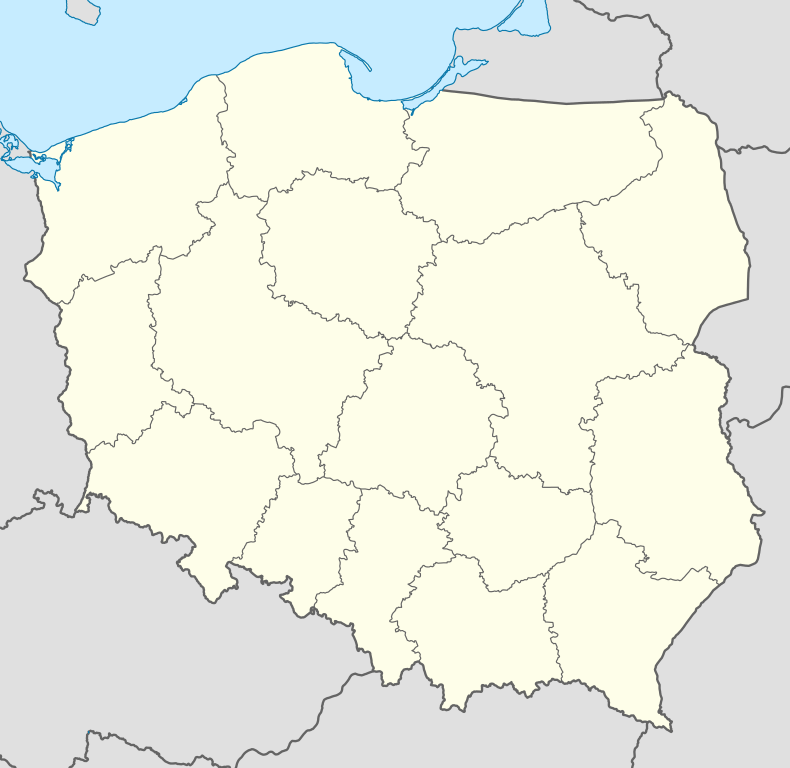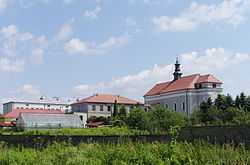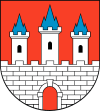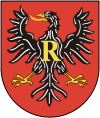Rawa Mazowiecka
| Rawa Mazowiecka | ||
|---|---|---|
|
Castle ruins (top) and St Paul Church (bottom) | ||
| ||
 Rawa Mazowiecka | ||
| Coordinates: 51°46′N 20°15′E / 51.767°N 20.250°E | ||
| Country |
| |
| Voivodeship | Łódź | |
| County | Rawa | |
| Gmina | Rawa Mazowiecka (urban gmina) | |
| Government | ||
| • Mayor | Eugeniusz Góraj | |
| Area | ||
| • Total | 13.67 km2 (5.28 sq mi) | |
| Population (2006) | ||
| • Total | 17,643 | |
| • Density | 1,300/km2 (3,300/sq mi) | |
| Time zone | CET (UTC+1) | |
| • Summer (DST) | CEST (UTC+2) | |
| Postal code | 96-200 - 96-201 | |
| Car plates | ERW | |
Rawa Mazowiecka [ˈrava mazɔˈvʲɛt͡ska] is a town in central Poland, with 17,765 inhabitants (2004). It lies in the Łódź Voivodeship and is the capital of Rawa County.
First mentioned in 1288, it received city rights in 1321. From 1562 the city hosted the Rawa Treasury for the Polish army. During an excavation in 1948, a hoard dating from 600 BC was found containing 4 underground rooms with barrels of gold and silver. A smaller treasure was found containing mainly bronze artefacts from the Trzciniec culture, dating from around 1700 BC.[1]
History
Rawa has a long and rich history. It used to be one of the most important cities of both the Kingdom of Poland and Polish-Lithuanian Commonwealth, and a capital of Rawa Voivodeship, a unit of administrative division which existed from 1462 until 1793. The starosta of Rawa was among most important personalities of ancient Poland, as he controlled the so-called “Rawa Treasury” - a large sum of tax money, kept at Rawa Castle for financing regular army units.
Rawa Mazowiecka was first mentioned in 1228, when it was a gord, probably located on one of local hills. In 1321, it received town charter, and in 1355-1370, a brick castle of Mazovian Dukes was built here. During the reign of Siemowit III, Duke of Masovia, Rawa was the capital of the whole Duchy of Mazovia.
In 1462, Rawa was annexed into Poland, and named capital of a voivodeship. The town prospered: wars of the 14th and 15th centuries did not affect it, and Rawa was one of the largest cities of Mazovia. In 1613, a Jesuit church was built here, and by 1622, Jesuit collegium was completed. Among its students was Jan Chryzostom Pasek.
The period of prosperity ended during the catastrophic Swedish invasion of Poland (1655 - 1660), when Rawa was captured by Swedes (September 8, 1655), who completely destroyed both town and castle (1657). Rawa never recovered from the destruction, and even though it continued to be the capital of Rawa Voivodeship, the town lost importance - in 1676, its population was only 100. In 1702, Swedish forces returned during the Great Northern War, once again destroying the town. In 1766, most of Rawa burned in a fire, and on February 4, 1793, the town was seized by the Kingdom of Prussia (see Partitions of Poland). In 1800, Rawa County was created, and in November 1806, during the Napoleonic Wars, Prussians left the town, which became part of the Duchy of Warsaw.
Since 1815, Rawa belonged to Russian-controlled Congress Poland. In 1822, a town hall was built together with tenement houses in the main town square, and in 1829-1830 a hospital was completed. Rawa quickly modernized, but this process was halted by the November Uprising. On February 4, 1863, Rawa was captured by the rebels of the January Uprising. The town was almost completely destroyed in 1915, and once again during World War Two, after which 60% of all buildings were in ruins.
The Nazis established a ghetto in Rawa Mazowiecka in March 1941. As Krzysztof Urbański informs in his book "Zagłada Żydów w dystrykcie radomskim", the ghetto consisted of two parts: "One area included a district called colloquially "the Jews", the second area was located at Łowicka Street. They included whole east part of the town, from the bridge on Rawka river to the bridge on Rylka river near the hospital. At the same time the area included the following streets: POW, Studzienna, Zatylna, Starościanska, Bóźnicza and Zamkowa Wola".
GHETTO IN RAWA MAZOWIECKA
Heritage Sites – Sites of martyrdom Polska / łódzkie
AuthorsUpdate articleUpdate mapUpload photoAdd audioAdd video
In March 1941, the Nazis established a ghetto in Rawa Mazowiecka. As Krzysztof Urbański informs in his book "Zagłada Żydów w dystrykcie radomskim", the ghetto consisted of two parts: "One area included a district called colloquially "the Jews", the second area was located at Łowicka Street. They included whole east part of the town, from the bridge on Rawka river to the bridge on Rylka river near the hospital. At the same time the area included the following streets: POW, Studzienna, Zatylna, Starościanska, Bóźnicza and Zamkowa Wola".
According to sztetl.org.pl, in 1942, the number of Jews in the Rawa ghetto grew to four thousand. Typhus epidemic broke out due to poor sanitary conditions. The Jews died as the result of diseases, starvation and occasional executions carried out in the castle. The dissolution of the ghetto started on 27 October 1942. The day before the action, about four thousand Jews from Biała Rawska were brought to Rawa Mazowiecka and spent that night in the open air. In the morning, the Germans surrounded the ghetto. The Jews were forced to leave their houses, and then were transported to the Treblinka death camp. Many town residents were killed during the ghetto liquidation. (source sztetl.org.pl and Yad Vashem online).
Rawa Castle
According to the Chronicle of Jan Długosz, the Rawa Castle was built by King Casimir III the Great, in order to protect southern part of Mazovia. Another chronicler, Jan of Czarnków, claims however that the castle was founded by Siemowit III, Duke of Masovia. It is not known when the construction began: probably it was in 1355. The castle was not completed until 1370, and by then, it served as administrative center of the Duchy of Rawa, which was independent in 1455 - 1462. On December 7, 1462, King Casimir IV visited the castle, announcing annexation of the Duchy of Rawa, and creation of Rawa Voivodeship.
In 1507, the complex burned in a fire, and two years ago, its reconstruction began. After ten years, the walls and the tower were strengthened. Since Rawa Castle was regarded as a modern fortress, in 1559 the so-called Rawa Treasure was placed here: the tax money needed to finance regular army. Development of military technology made the complex obsolete by the mid-17th century. In September 1655, it was captured by Swedes during the Deluge. In 1657, before their retreat, Swedish soldiers blew up most of the complex; only the tower and fragments of walls remained. Soon afterwards, high ranking Swedish officer Pontus De La Gardie was temporarily imprisoned in the remains of the castle.
After the destruction of 1657, the complex was not rebuilt, and by the early 18th century, it was a ruin. In 1789, the Sejm assigned money for its reconstruction, and assigned the task to Starosta of Rawa, Feliks Lanckoroński. His efforts most likely failed, as by 1794 the castle was abandoned. Prussian authorities ordered its demolition, in order to gain building materials. As a result, only the tower remained, with fragments of walls.
Prisoners of the Rawa Castle
In 1601 Carl Gyllenhielm, the so-called royal bastard, was brought to Rawa. Gyllenhjelm was captured in Valmiera by Lithuanians of Krzysztof Mikołaj "the Thunderbolt" Radziwiłł and Poles of Jan Zamoyski, during the Polish–Swedish War (1600–11). It is not known how long Swedish official was kept here.
Another famous prisoner of the Rawa Castle was Wawrzyniec Gradowski, a sorcerer and courtier of King Stephen Bathory, who in 1578 tried to poison him. Gradowski was locked in the castle, and died there.
See also
References
-
- ↑ http://www.bhzr.cba.pl/nbh/index.php?option=com_content&view=article&id=46:skarb-kwarciany&catid=25:zrodla&Itemid=49
Coordinates: 51°46′N 20°15′E / 51.767°N 20.250°E
| ||||||||||||||||
1.jpg)


